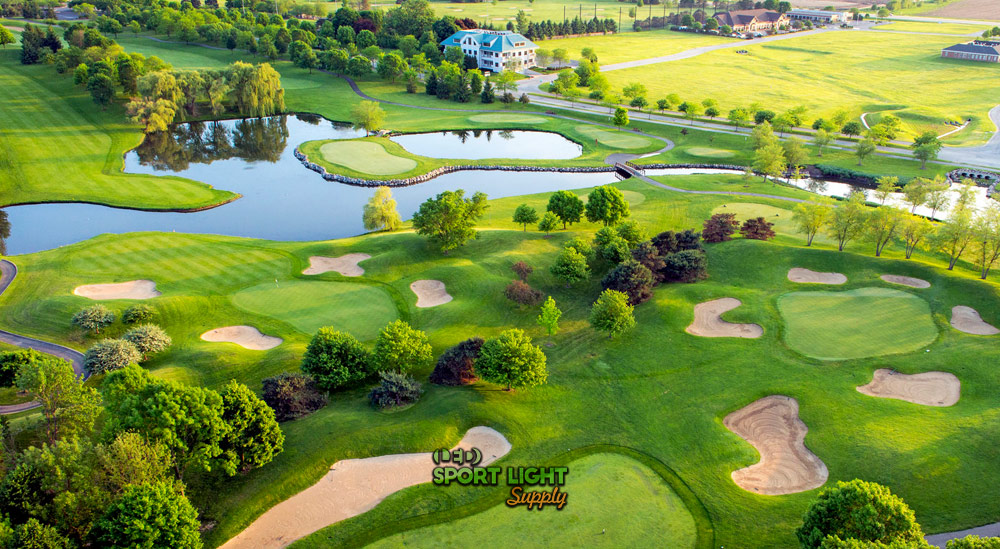Golf courses come in a variety of settings and sizes. Some are nestled within pristine natural environments, while others are situated among ancient oak, chestnut, and larch forests. In contrast, smaller golf courses with driving ranges are often located in more urban areas, leading to significant variation in size. The Golf Course Superintendent Association of America provides specific guidelines regarding the dimensions of golf courses, offering both precise and general information about their length.
For example, an 18-hole golf course is typically twice as long as a 9-hole course. However, predicting the length of a 3-hole golf course can be more challenging. This difficulty arises from the potential inclusion of additional features such as a driving range or a practice green, which can significantly influence the overall length of the course.
Table of Contents
ToggleWhy Understanding the Size and Dimension of a Golf Course Matters
Golf courses, designed by renowned architects, vary greatly in size and dimension to meet the needs of players, enhance the potential of the location, and align with the goals of the club or resort. The design often incorporates features like dog legs on fairways to create a visually engaging and memorable experience. Understanding the size and layout of a golf course is crucial for several reasons, including design requirements, lighting considerations, and capacity planning.
Better Golf Course Design and Layout

The design and layout of a golf course are intrinsically linked to its size and dimensions. Creating a golf course involves developing a comprehensive design concept that fits the specific characteristics of the land. Architects and engineers must assess feasibility and ensure that the design respects both the landscape and the environment.
The overall space required for an 18-hole course, for instance, differs significantly from that needed for a 3-hole course. The project’s scope can evolve based on the owner’s requests and the intended outcome, leading to adjustments in size before final approval. Therefore, understanding these dimensions is vital for creating a functional and aesthetically pleasing layout.
Better Lighting Design for Golf Courses

Lighting design is a critical aspect of golf course planning. The size and dimension of the course influence where lighting fixtures and poles are installed. For example, areas dedicated to chipping practice or putting greens require specific lighting setups.
Understanding the course’s size helps in determining the appropriate wattage and lumens needed for each area. Effective lighting design not only ensures visibility but also extends the usability of the course, allowing for longer playing hours. A well-planned lighting system enhances the overall experience and functionality of the golf course.
Calculating the Accommodation of Golfers
For golf course owners, understanding the dimensions of the course is essential for managing player capacity. This knowledge helps in calculating the maximum number of golfers who can be accommodated at any given time, directly impacting profitability and reservation management.
With accurate size and dimension information, owners can schedule tee times more effectively, allowing for optimal booking and smoother operation. This information also aids in staffing decisions and ensures that customer service is efficient and well-organized.
Are All Golf Courses the Same Size?
Golf courses vary greatly in size, and several factors influence their dimensions. Understanding these factors can provide insight into why courses differ so significantly. Here, we explore four primary causes that affect golf course size:
Level of Competition
The level of competition that a golf course is designed for greatly impacts its size and features. For instance, the requirements for a course hosting a local tournament differ from those needed for major events such as the PGA Championship or the US Open.
Higher-level competitions, particularly televised ones, demand stricter standards, including advanced lighting and layout considerations. For example, the US Open is designed to present a significant challenge to professional players, necessitating higher dimension standards and more sophisticated course features.
Number of Golf Holes
The number of holes on a golf course can vary based on its intended use and available space. Luxury resorts often feature 9-hole courses, which might also include additional amenities such as a driving range and practice greens.
Urban golf facilities might opt for a smaller 3-hole course due to space constraints or budget considerations. The choice of 18, 9, or 3 holes typically reflects the practicality and specific goals of the facility, with space and financial constraints playing a significant role in these decisions.
Complexity
Golf courses are not merely flat expanses of grass; they include various features that add to their complexity. Courses may have different terrains, such as uphill or downhill slopes, water hazards, and bunkers, which can affect the size and layout.
These features contribute to the difficulty level of the course and may need to be adapted based on the skill level of the players. Some obstacles might be natural, while others, like artificial streams, might be added to increase the challenge. The design must accommodate these elements to ensure that they enhance rather than hinder the golfing experience.
Construction Year
The age of a golf course can influence its dimensions and design features. Historical courses are often renovated to meet modern standards and incorporate current trends. Renovations may reflect updates in rules, such as those for ladies’ golf or televised events, which can result in changes to course dimensions and features.
Typically, a golf course undergoes some form of renovation approximately every twenty years. This process may also include updates to the lighting system and other infrastructure, potentially modifying the course’s size and layout to improve functionality and aesthetics.
Average Size and Dimensions of Golf Courses

Golf courses vary significantly in size and layout depending on their type and purpose. Here is a detailed look at the average sizes and dimensions for different types of golf courses:
18-Hole Golf Course
An average 18-hole golf course typically covers about 150 acres (approximately 60,000 square meters). However, there are notable exceptions, with some courses being significantly larger or smaller. For example, private country clubs in the U.S. might feature courses ranging from 90 acres to over 120 acres. A prominent example is the Richmond County Country Club in Staten Island, New York.
Internationally, some 18-hole courses are much larger. The Lijiang Jade Dragon Snow Mountain Golf Club in China, for instance, spans 329.5 acres (around 131,800 square meters), showcasing the vast range of course sizes.
Length of an 18-Hole Golf Course
The average length of an 18-hole golf course is approximately 6,500 yards (about 6,000 meters). The length can vary greatly based on the design and available space. For instance, the Lijiang Jade Dragon Snow Mountain Golf Club features one of the longest courses in the world, stretching over 8,500 yards (more than 7,800 meters). Larger areas allow for more extensive and challenging course designs.
9-Hole Golf Course
A 9-hole golf course generally covers 25 to 30 acres (between 10,000 and 12,000 square meters), which is about half the size of an 18-hole course. These courses typically measure around 3,000 yards in length. The dimensions of 9-hole courses can vary based on factors such as location, available space, and intended use, including amenities like golf lessons and junior programs.
Mini 3-Hole Golf Course
Mini 3-hole golf courses are much smaller, usually covering less than 1 acre (around 2,000 square meters). These courses are designed for short games or specific practice purposes. The hole size, depth, and radius in miniature courses follow different standards compared to standard courses.
Driving Range
Driving ranges typically occupy around 10 acres (approximately 4,000 square meters) of land. They often extend about 350 yards (325 meters) in length and may include various practice areas such as target greens, chipping areas, or putting greens.
Land Requirements for Building a Golf Course
To construct a standard golf course suitable for championships, you will need between 120 to 200 acres (or more) of land. Mini-golf courses, however, can be built on as little as 25 acres. It is essential to consult with golf course architects and adhere to regional regulations and association guidelines to ensure proper design and compliance.
Conclusion
The size and dimensions of golf courses vary widely based on their type, purpose, and location. While the standard 18-hole course typically spans around 150 acres, there are many variations based on design and regional factors. Understanding these dimensions helps in planning and designing golf courses to meet specific needs and standards.
